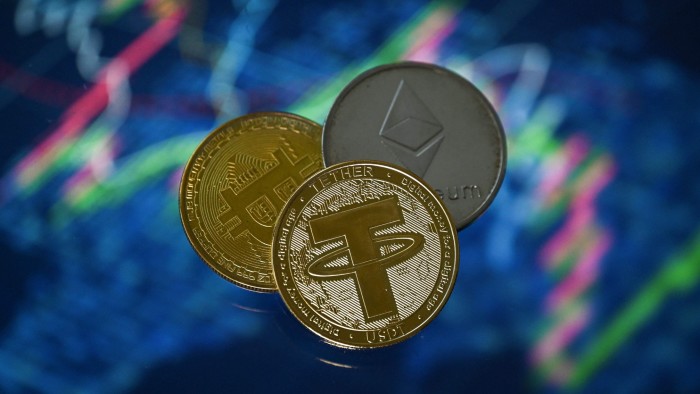Unlock the Editor’s Digest for free
Roula Khalaf, Editor of the FT, selects her favourite stories in this weekly newsletter.
Crypto has got its claws into the White House and is swiftly growing into a global financial stability risk.
Up to now, what happened in crypto stayed in crypto. If you buy a token of some kind — there are thousands of them out there, linked to everything from dog memes to the US president — and something goes wrong, it is on you. If the site where you store them goes bust or gets hacked, tough luck — you knew the risks.
“Hey, Crypto Mom, where’s my bailout?” is not an appropriate response to suffering losses, as Hester Peirce, the crypto-friendly commissioner at the Securities and Exchange Commission, said in May.
But we are rapidly reaching the point where the crypto ecosystem poses risks to mainstream markets, or what the crypto community would gratingly call “TradFi”. In fact, it is reaching the most trad market of all, US government debt — the bedrock of the global financial system.
The connective tissue here, between dog tokens and real life, is stablecoins — akin to normal currencies, chiefly dollars, but in the crypto ecosystem. It is much easier to hop in and out of bitcoin or other tokens by using a stablecoin such as tether or Circle’s USDC as a base, rather than a clunky real-world currency.
With stablecoins, the promise is that a dollar is a dollar. They are meant to be backed one for one with reserves of equal value. Holders do not receive interest (but the operators often do, to the tune of billions of dollars a year) or any adjustment for inflation. But they do get to shoot something that smells a bit like real money around the cryptosphere with great ease.
For years, this has been an intriguing sideshow on the periphery of global finance. Stablecoin operators have shown varying degrees of willingness to spell out exactly what they own, with Tether executive Paolo Ardoino once telling the Financial Times that was his “secret sauce”.
Back in 2021, warnings were emerging about the risk this poses to normal markets. Rating agency Fitch pointed out that if a stablecoin were to fold for any reason, it could be forced to sell all of its holdings — the dollar assets held in reserve — upsetting the underlying markets.
Last month, a working paper from the Bank for International Settlements, the central bank for central banks, cranked up the volume on that warning. In it, Rashad Ahmed and Iñaki Aldasoro calculate that when stablecoins (of which tether is by far the biggest and most impactful) draw in funds, and churn them into reserves, that has a marked impact on the value of short-term US government debt.
That is a reassuring sign that stablecoin operators are indeed buying reserves to match their inflows. Still, this is a substantial and little understood market force. According to the researchers, large inflows of $3.5bn over five days can place enough upward pressure on the price of short-term US government debt to pull down yields by up to 0.025 percentage points over 10 days.
That does not sound like much, but the paper says it is “comparable to that of small-scale quantitative easing on long-term yields” — in the same ballpark as central bank efforts to stimulate a flagging economy.
So that covers when stablecoin money comes in. But what happens when it goes out is more important: the impact on short-term government debt prices is two to three times larger. When money comes in, stablecoin operators can exercise some discretion over precisely how and when to buy reserves. When they face redemptions, they have to act faster.
We might cheer the ascent of stablecoins as a side-effect of the relentless crypto boosting from the Trump family, as it helps on the margins to lower borrowing costs. (Although it might be preferable for people to cut out the intermediary, buy short-term debt and enjoy the interest payments.) But if anything were to go wrong in crypto in future — hardly a wild theoretical exercise — we might all feel the ripple effects. And either way, it all adds an additional layer of complication for central banks.
“If the stablecoin sector continues to grow rapidly, it may eventually affect the pass-through of monetary policy to Treasury yields,” the researchers say, adding that the “opacity” of reserve holdings disclosure by tether “complicates” efforts to model its possible impacts.
The financial stability risks embedded in all this, at a time when the US is seeking to foster greater growth in stablecoins, are obvious. Stablecoin operators hold more short-term US debt securities than large foreign investors such as China. Between them, they bought more than $40bn worth of Treasury bills in 2024.
This moment calls for heavier regulatory requirements on stablecoin operators to report — in detail and often — what they are buying and selling. But the gutting of crypto regulation and enforcement under the second Trump administration suggests this is desperately unlikely. None of us should be surprised to see shocks emanating from this space, either while Trump is in office or beyond.
katie.martin@ft.com

